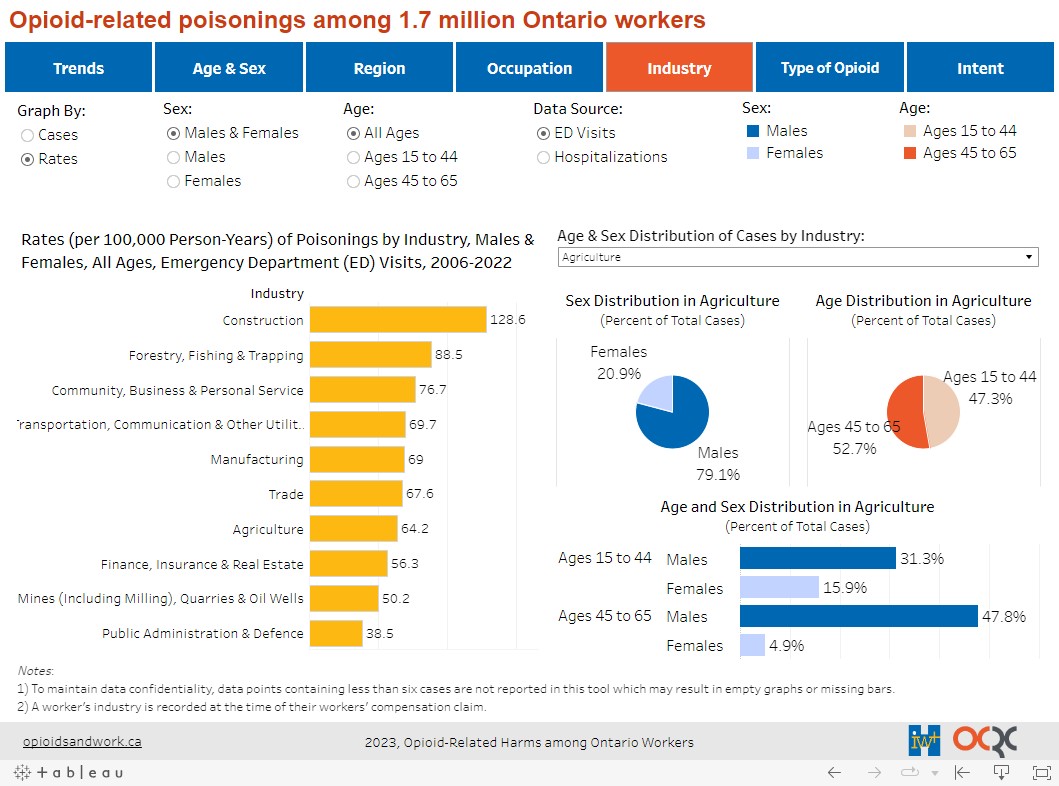Research identifies worker groups at the greatest risk of harm

There is a new tool shedding light on opioid-related incidents among Ontario workers. The Opioids and Work Data Tool was developed through a collaboration between the Institute for Work & Health (IWH) and the Occupational Cancer Research Centre (OCRC) and is an interactive data visualization tool that health and safety professionals can use to gain a deeper understanding of how the opioid epidemic shows up in workplaces.
“The impetus behind this project was that individuals of working age, particularly males, tend to be disproportionately affected by opioid-related harms,” explains Nancy Carnide, a scientist at the Institute for Work and Health. “Occupation was identified as a potential factor in this crisis."
She says the Opioids and Work Data Tool was conceived to bring awareness to opioid-related harms occurring among certain occupational groups.
A multifaceted resource
The tool includes three dashboards, each offering insights into different aspects of opioid-related harms – poisonings, mental and behavioral disorders, and adverse reactions. Drawing data from the Occupational Disease Surveillance System (ODSS), which covers approximately 1.7 million Ontario workers, the tool provides a unique perspective on the extent of these harms across various industries and regions.

According to Jeavana Sritharan, a scientist at the Occupational Cancer Research Centre and co-lead on the project, the tool's significance extends beyond its scientific contribution: "It's not just about the numbers. We aimed to create a web-based data visualization tool that workplaces, employers, employees, and health professionals could use to comprehend how opioid-related harms manifest within the Ontario worker population."
Harnessing the power of awareness
At its core, the Opioids and Work Data Tool seeks to raise awareness and foster discussions about the opioid crisis within the context of the workplace. "We want to start conversations about opioid-related harms, dispelling stereotypes and acknowledging that it could affect anyone – even your colleagues," says Carnide.
The tool provides the means to identify worker groups at the greatest risk of harm, paving the way for targeted interventions and policies. "If we can strategically target high-risk occupational groups," says Carnide, "we can develop tailored programs and educational campaigns to address the issue effectively."
A glimpse into the future
Construction industry workers may note that their sector tops the list for opioid-related poisonings. However, it's essential not to focus solely on one industry, as Sritharan explains: "While construction may lead in poisonings, it's just one piece of the puzzle. We're hoping to broaden awareness about other high-risk groups as well."
The Opioids and Work Data Tool also highlights regional disparities, with Northern Ontario experiencing higher levels of opioid-related harms than some urban areas. The reasons behind these differences are still being explored, but physical demands of certain jobs and the potential use of opioids to manage pain are factors that may play a role.
Continued data collection and beyond
The tool's data currently spans up to 2022, with plans for regular updates. "We will keep updating the cohort every few years, incorporating Workers' Compensation Board claims data and health records data,” says Sritharan. “Our goal is to expand the tool's capabilities to include prescription data and mortality rates."
"This tool is just the beginning,” proclaims Carnide with enthusiasm. “We see it as the foundation for future research and interventions. By bringing occupation into the conversation about opioid harms, we aim to drive meaningful change in occupational health and safety."
In a world where health and safety professionals face evolving challenges, the Opioids and Work Data Tool offers valuable insights into a problem that is considered one of the biggest threats to workplace safety.





